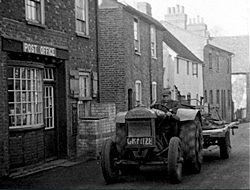Chatham Observer –
Friday July 30th 1943
PLANE RIPS TOPS OFF FARM COTTAGES: Several Injured in Crash Near Cobham
Three of crew killed
OCCUPANTS of
two farm cottages at Henhurst were injured-three seriously – when a plane
crashed into the cottages early on Sunday July 4th.
After
severing a telegraph pole the plane, which had been heard flying low, struck
the roof of the cottages and completely demolished the front bedrooms.
The force of
the impact broke the plane in two, half remaining on the roof of the cottages and
the engines and wings dropping into the gardens.
Only floors left
Only the
floors of the bedrooms remained. The walls were shattered and furniture was
scattered over a wide area.
The
occupants of the cottages were all in bed at the time. Mr. and Mrs. D. Danes
were thrown into the garden and their bed was found under part of the plane.
Mr. and Mrs.
W. Epps were left on part of their bed, the foot of which was wrenched off.
Mr. Epps
shouted to his son, Peter, aged 13, who was in a back bedroom.
Peter
bravely climbed through the fuselage of the plane to join his parents who were
unhurt.
Richard
Dines, who was sleeping in a back bedroom was also unharmed.
The injured
Frank,
another son, who was in a middle bedroom, received facial injuries. Mr. and
Mrs. Dines were removed to Gravesend Hospital in a serious condition. Mrs. Epps
was also detained with a fractured skull.
Mr. Epps and
Frank Dines were taken to hospital but were not detained.
Neighbours
were quickly on the scene and rendered assistance. These included War Reserve
Constable A. Russell. Special Constable B Parrish and E. V. Down, and Mr. R.
Wood.
One wing of
the plane caught fire, but fortunately the wind blew the flames away from the
cottages. This outbreak was soon extinguished.
Ambulances soon arrived to take the injured to
hospital.
Mr. V.
Russell, farm bailiff, described how he saw the plane as it flew low over his
house, which is about three-quarters of a mile from the cottages.
Heard a crash
“A
moment or so later”, he said, “I heard a crash. I got on my bicycle
and rode to the cottages as quickly as I could.”
Peter Epps
was relieved to find his pet kitten safe amid the wreckage and one of his first
acts was to see that it was cared for at a neighbour’s house.
The cottages
stand on their own. They are owned by Mr. J. W. Pye of Jeskyns Farm, Cobham,
who is chairman of Strood Rural Council.
Three
members of the wrecked plane were killed and two were injured.
Another
plane crashed on Cobham golf course. The crew baled out and there were no casualties.
Both planes were on their way home after a raid on enemy territory. It is believed that they were seeking to land but were unable to find the airdrome owing to a ground mist.
RAF 432 Squadron
03/04-07-1943 N0. 432 Squadron Wellington X HE630 QO-B
Base: RAF
Skipton-on-Swale, Yorkshire
Crash Site: Henhurst
Lane, Gravesend, Kent
Pilot: Sgt. Johial William Baker J/17766 RCAF age 22, Killed
Fl/Eng: P/O EW Bovard RAFVR, survived – injured
Air/Bmr/Obs: Sgt. Glen Edwin Lewis R/133341 RCAF age25,
Killed
W/Op/Air/Gnr: Sgt. Jack Holmes 1091687 RAFVR age 21. Killed
Air/Gnr. Sgt. D.K. Ryan RAFVR survived – injured
432
Squadron was formed at Skipton-on-Swale on 1st May, 1943. The squadron crest displays
a cougar leaping down in front of a full moon, symbolizing the many
night-bombing operations and the fight for the “light of freedom against
the darkness of oppression.” Beneath the crest sits the motto
“Saeviter ad lucem.” (“Ferociously towards the light”)
Flying as part of No. 6 (R.C.A.F.) Group, the unit was initially equipped with the Wellington bomber. The aircraft code “QO” signified the plane belonged to 432 Squadron. In September of 1943, East Moor became the new base for the unit. A month later, the group began to convert to the Lancaster. In February, 1944, the Halifax replaced the Lancaster as the squadron’s aircraft. The Halifax served the unit for the remainder of the Second World War. The last operational mission occurred on 25th April, 1945, when 19 Halifaxes bombed gun batteries on the island of Wangerooge. Among the 144 decorations awarded to the aircrew were over a hundred Distinguished Flying Crosse
Sources:
http://aircrewremembered.com/baker-jonial.html
http://www.bombercommandmuseum.ca/squadron_432.html
Don Blackburn Aug. 2018





